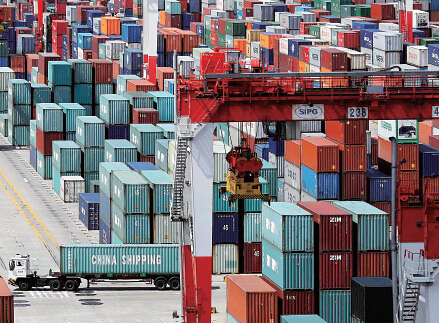Robust growth at Shanghai port
Updated: 2014-06-04 15:01
(China Daily)
|
|||||||||||
 |
| Container area at the Yangshan Deepwater Port, part of the Shanghai Free Trade Zone. Photo?by Carlos Barria /Reuters |
Shanghai port has been one of the world’s busiest ports for four consecutive years on the basis of its rising cargo volume.
In 2013, the cargo volume it handled increased by 8.1 percent over 2012 to reach 543 million tons, with bulk cargo growing by 10.5 percent to arrive at 204 million tons.
Container throughput rose by 3.8 percent from 2012 to hit 33.77 million twenty-foot equivalent units, top globally for the past four years, said Chen Xuyuan, chairman of the Shanghai International Port Group.
Shanghai port, managed by the group, saw dramatic growth of water-to-water transportation in 2013, which accounted for 46 percent of the city’s total volume. Its international shipping grew by a recordbreaking 35 percent.
The group will make full use of Free Trade Zone policies to expand its business in the fields of shipping finance and cargo consolidation logistics.
Shanghai developed into the world’s busiest container port in 2010 with its handling capacity reaching 29.05 million TUEs, beating Singapore which had only half of Shanghai’s container throughput.
The port of Shanghai, located on the middle of China’s eastern seaboard, is the most important transport hub in the Yangtze River Delta region, especially for foreign trade. It includes three major working zones at Wusongkou, Waigaoqiao and Yangshan.
To better serve clients, the Shanghai port has invested heavily in improving its facilities and services, Chen said. Its Yangshan deepwater port launched two-way navigation on its main channel in the second half of 2013, in a bid to better meet the increasing demand of the FTZ.
Experts said the two-way navigation will enlarge Yangshan’s capacity, reduce costs for shipping companies and improve safety.
Chen was quoted as saying that twoway navigation will shorten vessels’ waiting time on berth and improve efficiency for both the port and carriers. The new measure will benefit carriers calling at the port and companies in the shipping business in Shanghai.
Figures show that with two-way navigation, vessels’ average waiting time in Yangshan has shortened from 3.5 hours to 1.75 hours while berth utilization has risen to 84 percent from 72 percent.
Hot Topics
Wei Guirong drives his granddaughters from kindergarten on his home-made three-wheeled vehicle in Luorong county, Liuzhou city of Guangxi Zhuang autonomous region, on May 19.
Editor's Picks

|

|

|

|

|

|






